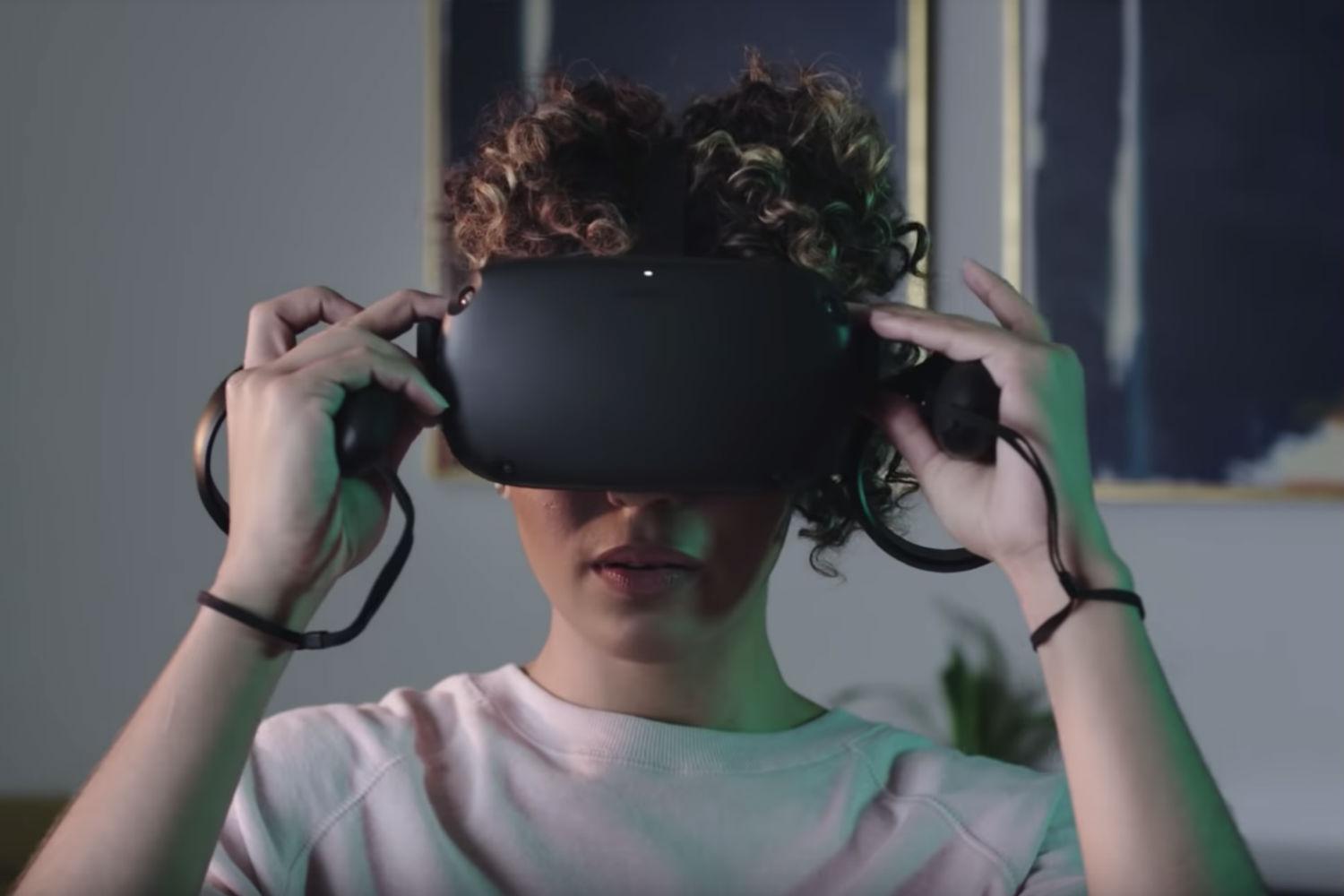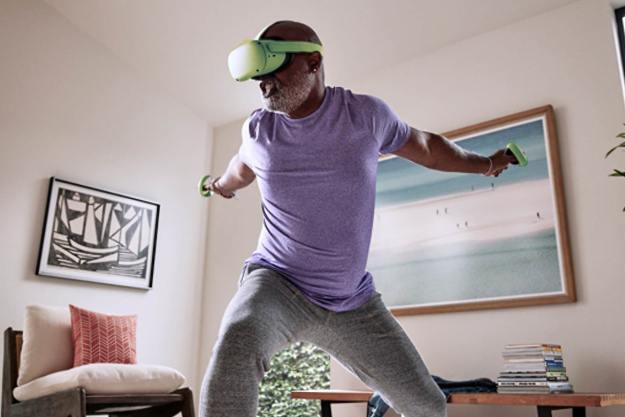Virtual reality is still a relatively new concept with plenty of room for improvement, but the Oculus Rift headset is one of the top competitors. With the introduction of the Oculus Quest headset, many people are wondering how the two products measure up to each other.
By comparing factors like design, price, and performance, we can help you figure out which VR headset is the better choice for you.
Design
The Oculus Rift is the older of the two designs and though it does show, it’s not an antiquated device. It sports a similar fabric-coated exterior to the Quest, a similar tri-strap adjustable head mount, and built-in audio. But it’s not identical to the Quest. The Rift is lighter by a full 100 grams, due to the onboard hardware of the Quest, which includes its own processor and battery for wireless operation.
That does mean that the Rift trails wires, where the Quest does not, making the latter a much cleaner-looking headset, especially considering its newly revamped front plate, which wraps around the corners where the four Oculus Insight tracking sensors are located.
Instead of over-the-ear headphones like the Rift, the Quest comes with similar audio to the Oculus Go — a spatial audio solution hidden in the head strap. That makes it easier to hear what’s going on in the environment around you, whilst still being fully immersed in your VR experience. It’s not necessarily better quality, but it certainly makes it easier to remain present in both the real and virtual worlds.
Performance
The Oculus Quest is the most powerful stand-alone headset Oculus VR has ever produced, packing a Qualcomm Snapdragon 835 processor with onboard graphics, 64GB or 128GB of onboard storage, and a battery that gives it between two and three hours of life per charge. As impressive as that all is though, it falls well short of what the Rift can offer, since the wired headset is tethered to a gaming PC. Oculus suggests much higher minimum specifications and the ceiling is far, far higher for potential performance than the Quest’s — think RTX 2080 and 2080 Ti graphics cards. Yet no matter how powerful the PC you hook it up to as well, there’s no concern about battery life, since the headset is powered by your PC via a wired connection.
However, in 2019 Oculus also introduced software called Oculus Link. Provided that players have a compatible USB 3 cable and a gaming PC, they can connect their Quest and use it to play Oculus Rift games. With this setup, it all but eliminates the need for a player to own both the Quest and the Rift.
The Rift is capable of running much more detailed virtual reality scenes than the Quest — and for longer — but its display has fewer pixels. The Rift’s dual-OLED panels are limited to 1,080 x 1,200 pixels per eye, working out to 2,160 x 1,080 resolution in total. In comparison, the Oculus Quest has twin OLED displays that are 1,600 x 1,440 each, or 3,200 x 1,440. That makes for sharper overall visuals, with a noticeably reduced screen-door effect on the Quest, but its in-game textures, shaders, and models are a far cry from the Rift’s PC-powered visuals.
The Oculus Rift S, however, is more comparable to the Quest in terms of its pixel count. The resolution is 2560×1440, and you can expect the sharpest image quality on the Rift S compared to the Quest and the original Rift.
The Rift handles high-speed motion better than the Quest too, because while its displays are a lower resolution, they have a higher refresh rate. The Quest runs at 72Hz, while the Rift has a fixed 90Hz and the Rift S is 80Hz. That should make it more comfortable for the user too, helping to avoid the dreaded VR nausea.
Tracking and controllers

Both the Rift and the Quest offer high-end virtual reality tracking and inputs. In the case of the original Rift, however, it offers a very different technology for doing it. The Rift uses the classic external-tracker design using Oculus’ Constellation tracking cameras. Although they aren’t as capable a tracking solution as the HTC Vive’s Valve-developed Lighthouse trackers, they are perfectly capable of offering room-scale tracking in spaces up to 8 feet by 8 feet with three sensor set up.
The Rift’s external trackers mean it’s possible to track the controllers almost anywhere you place them, whether that be behind your back or under objects — as long as they remain in the field of view of at least one camera.
In comparison, the Quest offers a theoretically unlimited tracking area thanks to its use of “inside-out tracking,” Insight sensors on the headset itself. One is located in each corner for a total of four and they scan the environment around the user, tracking their location and movements within it, as well as the motion of the controllers. Oculus debuted what it described as “arena scale” tracking at Oculus Connect 2018, where a number of Quest users walked around a tennis court-sized gaming area at the same time without any major tracking problems. This was further enhanced by the headset’s lack of any wired-tethers, letting users roam freely without being tied down.
However, the controllers must remain within the field of view of the headset’s wide-angle sensors in order to remain tracked. Early testing suggests their field of view is wider than the user’s, but tracking behind the back, or when the user is leaned in close to something, is unlikely to be possible at this time.
Oculus Rift S switched to a similar inside-out tracking system via Oculus Insight, allowing players to enjoy VR without setting up external sensors in their play area.
Each headset provides a full six-degrees of freedom to the wearer, tracking positional movements, as well as tilt and orientation of the headset, but each solution has its strengths and weaknesses.
Controllers are much the same for both. The Rift uses Oculus’ now-classic Touch motion controllers which provide trigger, grip, and gesture inputs, and the Quest uses a modified version of those with a relocated tracking ring. Each provides for nuanced, detailed, inputs into virtual reality with the use of both the wearer’s hands.
Beginning in 2019, Oculus also began experimenting with controller-free tracking. Its use is limited in games at the moment, but Rift S and Quest players can control certain functions and apps on their headset through their hands alone. Their individual fingers are tracked as if they were controllers, potentially paving the way for a world in which we don’t use controllers in VR at all.
Software
Having been on the market for nearly four years, the Oculus Rift has a library of games, VR experiences, and 360-degree media numbering in the low thousands. It has a variety of supporting marketplaces and ecosystems, including Oculus Home, Steam VR, and VivePort, and a robust developer and user base that all but guarantees continued support and growth in its content catalog in the future.
The Oculus Quest, on the other hand, is relatively new. Many of the games we’ve seen on the headset thus far have been ports of titles from older VR headsets, as well as a selection of Oculus first-party games released simultaneously with their Rift versions. It’s not limited on games, however, as the number continues to grow and there are a particularly high number of fitness and puzzle games to choose from.
What’s even more exciting for Quest owners is that along with support for Rift games via Oculus Link, developers are interested in making Quest games. In a poll of VR developers ahead of GDC 2020, Oculus Quest was the most popular choice for development, with Rift slightly behind. This means we are likely to see the Quest’s library grow even larger, and possibly with exclusive games rather than Rift, PlayStation VR, and Vive ports.
The new kid takes the crown
The Oculus Rift is a powerful and capable VR headset with a library of games that can keep players busy for years without repeating any content. That is undeniable, and the resolution players get on the headset is better than the Oculus Quest and several other competitors.
However, the Oculus Quest represents something that virtual reality has been striving for since its mainstream revival in 2012: Convenience. Being able to just put on the headset and begin playing games in minutes makes it a far more enjoyable experience despite the decreased power, and the game selection is growing quickly. For fitness, it’s even more alluring. Not being bundled down by wires not only means you can game in your living room instead of your office, but also that there is less risk of accidentally tripping over a wire and hurting yourself.
Add in support for Oculus Rift games via the Oculus Link accessory and the ability to take the headset almost anywhere to play games, and the Quest becomes the clear winner. As long as Quest players have access to Rift games via a PC as well, it’s difficult to see the Rift every taking back the lead.
Overall winner: Oculus Quest
Editors' Recommendations
- Quest Pro 2: What we know about Meta’s next premium VR headset
- Meta Quest 4: Here’s what we want from the next big VR headset
- Your Quest 3 just got so much better — for free
- These are all the must-try apps for your Meta Quest 3
- A cheaper version of the Meta Quest 3 now seems more likely than ever




